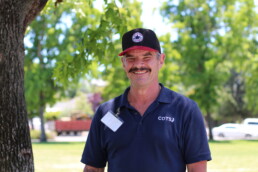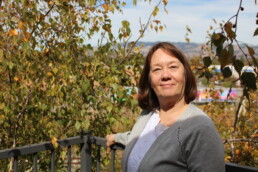The COTS Collective: June 2023


Celebrating Six Months
In January, I stepped into the COTS Chief Executive Officer role following Chuck Fernandez. Chuck left big shoes to fill and had built an incredible team of professionals to move the COTS mission forward. I wanted to take a moment to thank Chuck for his work here at COTS, and to celebrate the first six months of 2023. We have already accomplished so much!
So far in 2023, the COTS team has updated its program policies to be more inclusive, helping our clients achieve greater success on their unique pathways to housing. We have laid the foundation for a large expansion of both our Recuperative Care program, and our Permanent Supportive Housing program. By Spring of 2024, COTS will have expanded its Recuperative Care capacity by more than 200% and will have added 14 new units of permanent supportive housing in Sonoma County. The COTS team held its first in-person fundraiser since 2019, strengthened its community partnerships, and worked alongside Burbank Housing in the opening of a new 60-unit permanent supportive housing project in Petaluma. We have onboarded several talented team members, started a new 5-year strategic plan, and increased our capacity to serve each unique client in ways most meaningful to them.
We are looking forward to our next six months. If you are interested in joining us as a volunteer, donating to our critical mission, or learning more about upcoming events, please visit our website at www.cots.org.
Until next time,
Chris Cabral
Mission Moment—A Staff Highlight: Stacie Questoni
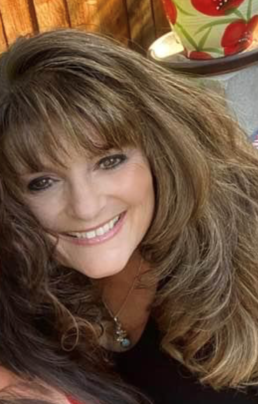
COTS could not accomplish all we do without an incredible team of dedicated staff members. We want to take a moment to celebrate Stacie Questoni, the People’s Village Services Manager. Since 2020, Stacie has been an invaluable member of the COTS team.
Ask anyone at COTS about Stacie and you’re sure to elicit smiles, laughter, and words of genuine love and camaraderie. Stacie helps our clients navigate their pathway to housing and has worked to help dozens of unsheltered community members find permanent housing right here in Sonoma County.
We asked Stacie to share a bit about herself and her work at COTS. Keep reading to learn more about Stacie’s passion for our work.
What do you love most about working at COTS?
First and foremost, I love the mission of COTS. I love the collaboration I have with my community partners, my coworkers, and my incredible boss. I love being in the role of helping others help themselves, giving them the tools and services they need to make better life decisions and seeing them blossom. COTS has a family feel to it and they care about you as a person and put your self-care as a priority.
Can you tell us about a recent client success story?
We have had many success stories in the short time People’s Village has been open. We have had 63 residents come through the program and 18 of those residents have been housed since the inception of the program March 2021.
One gentleman who has been highly resistant to services finally agreed to come into People’s Village. He stayed in our program for longer than a year, getting his medical issues taken care of, and working with VA. Due to the flexibility of our program, he was able to have the time he needed to work on those issues and COTS was able to get his VA discharge corrected so he could qualify for a VA housing voucher. Now, he is housed!
A female resident who has been unsheltered in the community since 2009 finally decided to come to COTS for services. She worked with staff to address her substance use, and after extensive engagements and a stay at People’s Village, she now has permanent housing at the new Studios at Montero program in Petaluma, CA.
What hobbies do you have outside of work?
Outside of work I enjoy spending time with my two adult sons, Dario and Luca. I enjoy traveling, (last year I went to Guatemala and New York, this year Boston and to be determined) spending time with my friends, hiking, camping, listening to live music, spa days, gardening, reading, and watching documentaries.
What would you like to see for People’s Village in the next three years?
I would like to see more mental health resources at People’s Village and in the community. I would also love to see an expansion of the program by adding additional tiny homes for people in need.
A big thanks to Stacie for all of her hard work and compassionate care to those we serve. Keep up the amazing work, Stacie!
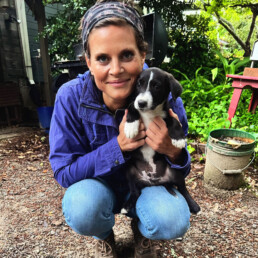
Sincerely,

Chris Cabral, CEO
The COTS Collective: May 2023


Celebrating a Successful Hops for Homes Fundraiser
In April, COTS hosted its annual Hops for Homes fundraiser at Brewster’s Beer Garden in downtown Petaluma. We are incredibly grateful to those who came to the event, and humbled by those who continue to show such strong support for our critical programs. We raised over $95,000 and enjoyed a fun-filled evening celebrating COTS’ 35th anniversary. All funds raised are used to provide essential services, programs, and resources to individuals and families experiencing homelessness in our community.
Hops for Homes brought together community members, elected officials, volunteers, staff members, and generous donors who are committed to making a positive impact on the lives of those in need. We shared stories of hope and resilience, highlighting the continued need for innovative solutions to ending homelessness in Sonoma County. The event was a resounding success—many attendees expressed their support and enthusiasm for COTS’ mission and thanked our speakers for sharing their inspiring stories.
“We are incredibly grateful for the overwhelming support we received at this year’s fundraiser,” said Erin Krueger, Development Director at COTS. “The funds raised will enable us to continue providing vital services and resources to those experiencing homelessness in Petaluma and the rest of Sonoma County. Together, we are making a significant difference in the lives of individuals and families, helping them move toward self-sufficiency and a brighter future.“
To learn more about the services COTS offers, please visit our website here.
On behalf of COTS, I would like to express my sincere appreciation to all event attendees, donors, volunteers, staff, and community partners who contributed to the success of Hops for Homes. Your generosity and dedication exemplify the spirit of compassion and unity that defines the Sonoma County community.
We hope to see all of you at next year’s fundraiser!
Until next time,
Chris Cabral
Mission Moment—Studios at Montero Brings Hope for New Tenants

“Welcome Home” balloons greeted clients – along with staff from COTS and Burbank Housing – at the Studios at Montero soft opening earlier this month
Studios at Montero is the conversion of a 50-year-old motel into 60 units of permanent supportive housing for chronically homeless people in Sonoma County. COTS is thrilled to partner with Burbank Housing and the City of Petaluma on this incredible project.
Studios at Montero (“SAM”) officially welcomed the first tenants earlier this month. All 60 units at SAM are fully remodeled studio units which come fully furnished. All new tenants also receive a welcome-home basket full of household goods to help ensure a successful and warm transition into their new homes.
COTS is proud to offer long-term, wraparound supportive services at this project, ensuring tenants feel safe and supported during their transition into permanent housing. Tenants are offered comprehensive case management, peer support services, access to onsite and offsite group recreation, healthcare coordination, and many other supportive services to help create a sense of safety, self-sufficiency, and instill confidence.
Projects like Studios at Montero bring hope to those experiencing homelessness right here in Sonoma County. Here at COTS, we have an immense sense of pride in serving our community, and we thank you for your continued support in upholding our mission.

Sincerely,

Chris Cabral, CEO
Stacie & David's Story
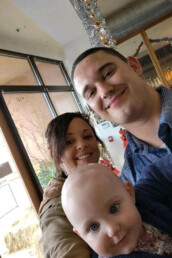
Stacie was nine months pregnant when she and David arrived at COTS’ Mary Isaak Center, looking for help. “I was actually pacing in the lobby with false labor pains,” Stacie says. “I was desperate. I didn’t want to bring our baby home to live in a car.”
Both of them knew they wanted something different for their child.
“Neither of us was raised right,” David says. “We were pretty much on our own growing up, pretty much surrounded by people who weren’t good influences. When we got together, we decided to change things for ourselves.”
Together, and while still homeless, the couple stopped using drugs and alcohol. And they put distance between themselves and the friends and family who encouraged their drug use.
For David, who grew up in Geyserville, that meant leaving behind almost everyone he knew, including the Dad who had introduced him to drugs while David was in middle school. Despite his drug use and despite the fact that he had to work fulltime to keep the lights on and the cupboards full for himself and his little brother, David graduated from high school. He knew he liked learning.
“But the whole time, I was hanging out with my Dad and his friends, not kids my own age. And I realized one day that every single one of them had been to prison. Everyone I knew had killed someone or robbed a bank or was some kind of career criminal.”
At 27, David had a brush with the law that could have turned into a disaster. Thankfully, it didn’t.
He took it as a sign to change. “My friends would say that it proved I was lucky, and I should keep going. For me, I knew this was my chance. I felt it.”
Stacie left home the day she turned 18 to escape a stepfather who was unpredictable in everything expect his vindictiveness. “I never knew if I’d be locked in the house or locked out,” Stacie says. “I never knew if he was going to lock the food up.” Her mom told her she couldn’t help.
After leaving home, Stacie married and had children. But the marriage ended in divorce and a custody battle. She ended up homeless.
For her, starting to use drugs and quitting drugs were both about survival. “When you’re out there, you use because you’re cold,” she says. “You use because you’re hungry and it takes away your appetite. You use because you feel so bad. People just walk past, and you take that in and you feel invisible. You feel worse. So you use and you feel better.”
Until one day after about six months of using, “I was almost dead. And I thought, ‘My kids deserve better than this. If I was a kid I would want my mom to fight.’ And I did. And I am.”
Together, David and Stacie began to fight their way back. They lived first in a van and then in a car. And they stayed sober together. Stacie won back visitations with her children. As he always has, David worked. He worked a string of low-paying jobs until he found one in construction that paid well.
They spent over a year homeless.
Then, one day at the end of a workday, they came to the Mary Isaak Center. David talked to the site coordinator at our front desk while Stacey paced the lobby.
“Silvia, who worked there, took one look at me and said, ‘What is going on?’” says Stacie. “She said, ‘Come in here and talk to me.’”
That conversation set things in motion, and, with help from COTS’ Rapid Re-Housing program, the couple moved into their own rental apartment three days before baby Hannah was born. “We took her home to a home,” says David.
“COTS helped make it happen,” says Case Manager Carmen Razo-Clark. “But they were persistent. They showed the landlord they were serious. It’s what we wish every client could do.” Thanks to David’s construction job, they had the income to get back on their feet. And thanks to Stacie’s organizational skills, they were able to wade through all the landlord’s paperwork and all our paperwork. Stacie even convinced the landlord to lower the rent by a few dollars to ensure that the unit would fit our program guidelines.
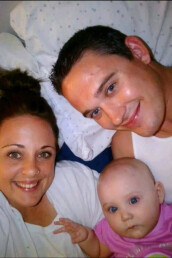
Their can-do spirit springs from their partnership. “They are a team,” Carmen says.
Carmen set them up with Rapid Re-Housing, a six-month program in which COTS would pay a portion of their rent while providing services and coaching. She met with Stacie and David regularly to go over their finances. “The budget, for me, is the most important thing,” Carmen says. “If it’s not balanced, that’s how I know they need more support.”

Soon after Hannah came home from the hospital, the family’s landlord decided to sell the home and gave them notice to leave.
“Panic, that’s what I felt,” says Stacie. “I had a newborn. I was freaking out. Carmen just said, ‘Let me look into it.’”
“The beauty of the program is that we are involved for many months,” Carmen says. “If things go wrong, we can help.” She made a call to a property manager who’d worked with COTS before and convinced her to meet Stacie and David.
“I let them know they would have to build a rapport and establish trust with the lady. They did the rest,” Carmen says. The couple found their second apartment and moved in.
“So much about Rapid Re-Housing has been about people giving us a chance,” says David. “Before this, I feel like we had so many doors closed on us.”
Months have passed since COTS’ financial payments ended. Now, David is working in auto sales and is studying to make a shift to the insurance industry. Stacie is staying at home with Hannah (who just turned one) and is pursuing shared custody of her other children. Her goal is to go to school in order to help other people regain their footing and find housing.
Dana's Story
“It’s pretty self-explanatory,” Dana Moses said. “I was homeless and now I help the homeless.” Then he laughed. “Nah, there’s a little more to it than that.”
At the beginning of 2020, Dana had his own painting business, and had been living in Cloverdale for 10 years. Then Covid hit. “I lost my place, I lost all my business,” he said. “I started living on the river, under a bridge.” He’d struggled with addiction before, and after becoming homeless, began using again.
Ironically, it was the fires that saved him. “They had an evacuation shelter at the fairgrounds, and I went there,” he says. “Someone with COTS was doing interviews in case people had nowhere to go. I did one, and they brought me over to COTS.” Dana got right in. “I was lucky,” he said.
That was August 26th, just over a year ago. A week or so later, Shelter Services Manager Robin Phoenix was looking for volunteers to clean up a campsite that had been abandoned, and he agreed to help out. “By doing that I think I showed Robin a little something,” he said. “That’s how I got steered into the Downtown Streets Team. Getting motivated with that opened up a whole bunch of other new doors. That was the pivotal turning point for me, that got me out of bed every morning, that made me believe in myself.”
Downtown Streets Team is a partner nonprofit that provides work experience to homeless individuals through street cleaning and creek restoration – offering leadership opportunities and housing/employment resources at the same time. It was the Downtown Streets Team that helped him get sober. “When I first started, I was smoking weed five minutes before I got there.” Then they promoted him from a yellow shirt to a green shirt, a position of leadership that meant he would lead a Team of his own. “I started thinking, well God, I have leadership now; how are these people supposed to respect me and follow me if I’m high while I’m doing it?” He decided to get clean.
From there, more doors began to open. His Case Manager, Christina Madden, referred him to a Sober Living Environment (SLE) in Petaluma. “It just so happens that that day, I had thirty days [of sobriety], and the SLE required 30 days clean. It’s weird, it’s just how everything fell into place.”
His new living situation meant he passed the Mary Isaak Center walking home from his mornings with the Downtown Streets Team, and soon he began volunteering at Mary’s Table. Then a position opened for a Kitchen Utility Worker, and a COTS Site Coordinator encouraged him to apply. A month later, he was employed full-time.
Now, he has a second job at Preferred Sonoma Caterers (a connection he made while working in the kitchen), his driver’s license, and a car (thanks to a generous donor), and is still stably housed in the same SLE he moved into last October.
“I’m very proud of what I’ve done, and I carry it with me,” he said. “I showed up a severe addict, and now I’ll have a year sober October 1st, God willing. I was a different person, and I’m starting to learn how giving back is just as rewarding.
“I owe most all of it to COTS, and [COTS staff] Robin, Christina, Janin, Max, and Chris all taking the time and effort to steer me in the right direction. I did the work, but they took the time to show me how to do it.”
Brandy & Josh's Story
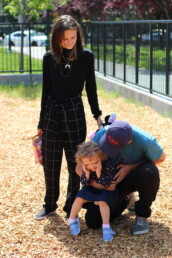
“We’re going to the store in a little bit, baby,” Brandy says, patiently. She’s speaking to her daughter, Luna, who’s anxious to head out to the grocery store. “She’s gonna be four in June,” Brandy says. “She just started having conversations with us recently, like full on back and forth. One sentence doesn’t necessarily mean one topic,” she adds with a laugh.
Luna has always been Brandy and her husband Josh’s primary motivation for getting a place of their own. Before coming to COTS, the family was living with Josh’s father, a connection made when Brandy, Josh, and Josh’s father were staying at Catholic Charities. Josh’s father started receiving housing assistance, and he asked if they’d move in with him, but the situation was volatile from the start. “From what [Brandy] told me, [Josh’s dad] drank an awful lot,” says Wendy Lindberg, who was the family’s case manager at the Kids First Family Shelter (KFFS). “It was a very abusive situation, and she didn’t feel safe, and didn’t want Luna in that situation.”
Six months after moving in with Josh’s father, things came to a head. “One day he just decided to get in my face over me putting the dishes away wrong,” Brandy says. “He’s not been a great man to my husband or his other kids, but that was the first time he ever decided to do something like that with me. [So] we left ‘cause we didn’t want our daughter to be around stuff like that anymore, and we didn’t wanna be going through it anymore; it just wasn’t healthy for anyone involved.”
Fortunately, Brandy’s uncle and aunt were able to take Luna while Brandy and Josh stayed in their car, figuring out next steps. “That’s when we got ahold of COTS,” Brandy says.
From the moment they arrived, the couple worked hard to meet their goals of getting into permanent housing. Josh was a few months into a plumbing job, and was often busy with work, so Brandy primarily met with Wendy for case management. They worked on daycare and head-start applications for Luna, which both had long wait lists; Brandy, who was unemployed, got a job at Staples within the first two weeks of their stay.
Eileen Morris, Client Enrichment Manager, assisted the couple with credit repair, helping to eliminate an outstanding Verizon bill from Josh’s credit history, and building Brandy’s credit up with a prepaid, low-limit credit card. “As far as financial help, I didn’t help them a whole lot, because they really didn’t need it,” says Wendy. “I tried to do a few things for them, but they really wanted to do it on their own.” The couple was spending too much on eating out, so Wendy worked with them on budgeting, and making meals at home. “They probably didn’t have a lot of that from their background, cooking, so that was hard for them to learn how to do,” Wendy says.
During their stay, Brandy began struggling with her job, stating that she felt she wasn’t given enough training for the work she was being assigned. “She was becoming extremely stressed and anxious, at the job and when she got home,” says Wendy. “We discussed options, and she decided to stick it out and to ask for help from Josh, who was very supportive. I also let her know that Luna could come and play with me if she needed some time for herself on her days off.”
“Wendy, she was just amazing,” says Brandy. “She was a friendly face every time, just always asking how we were doing, she totally helped us out. This was a really hard time in our lives, and it helped us out immensely, I couldn’t honestly be more grateful.”
Brandy told Wendy they were considering getting an apartment with Josh’s brother and his fiancé (now wife), which Wendy encouraged them to do. They began applying to places on their own, and just over six months after moving into KFFS, the family found a cozy two-bedroom condo in Santa Rosa to share. “We moved into our new place on New Year’s Day,” says Brandy. “It was a pretty neat way to start the year.”

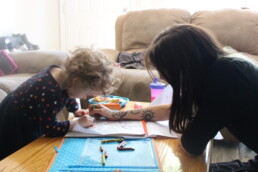
During their time at KFFS, Josh had gotten a $500 hiring bonus for getting his brother a job, Brandy had been offered full-time with benefits, and between their stimulus checks and Josh’s work bonuses and raises, the couple had been able to save $7000 for their move-in expenses. “They were sober when they came in, probably for at least a few months,” says Wendy, “and they stayed sober, which was amazing; the situation of being homeless is stressful.”
And now? “It’s going well, everything is a lot better,” Brandy says of their new living situation. There’s a park across the street from their complex that Luna loves to play in, and a kitchen for Josh to make grilled cheese sandwiches and sliced apples when Luna gets hangry. They have a dog, Freya, and Luna can watch Mickey and Scooby Doo in their living room. Brandy and Josh are teaching her that it’s okay to be upset and helping her express her feelings and her needs in a productive way. And Brandy and Josh have a loving, supportive place to come home to after work, with a door to close and lock behind them.
“My husband and his family have struggled with homelessness on and off since they were kids,” Brandy says. “I think this is the first place his youngest brother has had to live in maybe four years, so it’s good for all of us. We’re finally in a stable spot, and it’s so good just to be able to look back and say, ‘shit I made it.’” Then she added with a laugh, “I didn’t mean to swear, my bad!”
“Everything is on a better track than I ever thought I’d be able to get myself to,” she says. “That steppingstone that COTS gave us was really, really great, and everything is for the better for it. We finally got ourselves to a point where we can build from, so it’s just up from here. We’re just so appreciative of the opportunities COTS gave us.”

Skyler's Story
“Well, I moved here three years ago from Missouri, ‘cause of her,” Skyler Padgett says, gesturing to his wife, Tricia Potter. They’re sitting on the back porch outside their Santa Rosa home, under a shady overhang, wind chimes tinkling behind them, and this makes them both smile. “We met in a LGBTQ+ group on Facebook. And we started talking and just instantly connected.”
“Life in St. Louis wasn't that great for me,” he continues. “St. Louis is not trans-friendly at all. A friend of mine had been murdered there, for being trans. So I knew there was no way I could be there and live my life how I wanted to be, to live as my true self.”
When Skyler and Tricia met, he was running the cafeteria at Edward Jones. “This is before I came out as trans,” Skyler says, “and I didn't shave one day. And my boss told me, ‘You need to go home and shave.’ And I was like, ‘I don't want to.’ My boss said, ‘Well, if you don't shave, we have a problem.’ So I didn't shave. And I went from being in charge of the cafeteria to demoted to a grill cook.” Then, as he was driving home, he received a call letting him know that he no longer had a position with the company. “That was the final straw.”
Skyler had been stationed in San Diego when he was in the Navy, so he was familiar with California, and already loved it. “My first Pride was in San Francisco,” he says, “so I fell in love with California like that. [When I was there] I thought, this is my home. This is where I wanna live.” So when Trisha asked him to move out to California with her, it was a no brainer.
At the time, Tricia was living with a friend in a studio apartment in Guerneville. “Already two people in a studio is a lot, but three people in a studio?” Tricia says with a laugh. While they were looking for a bigger place, they stayed with Tricia’s sister on her living room floor for a time. Then an acquaintance had a mother-in-law unit in Cloverdale, but unfortunately, the situation devolved quickly. “We were only there for a month, and that's when we found COTS,” she says.
They got connected to COTS through the Veteran’s Resource Center (VRC, now Nation’s Finest), where Skyler was employed as a cook. With bad credit between them and Tricia's emotional support cat, they found it nearly impossible to find viable housing options. One after another, they applied to and either were rejected or had units fall through, mostly due to credit checks. “I was at the point where I was just ready to give up,” Skyler says. “We were looking at sleeping in our car.”
In the nick of time, Skyler’s case manager, Trevor, found them a house in Bennett Valley. They had a roommate, Art, an older Vietnam vet who also served in the Navy, and a spacious three-bedroom house with hardwood floors and a built-in closet. Skyler and Art hit it off “like peas and carrots,” says Tricia. It felt like a dream come true.
Then, the owner sold the building, and they had to move. They were devastated.
They moved into another shared living situation with several housemates, including a couple who lived downstairs. It was alright at first. "The wife and [Tricia] became friends," Skyler said. "But then there was a confrontation, and I was called an 'it' by her husband." The tension in the house became unbearable.
Eventually, COTS broke off its agreement with the landlord, and moved all the tenants out of the house into other units.
That led Skyler and Tricia to the house they live in now. They were nervous at first because they were going to have roommates again. "I don't like to come out as trans [at home] because I don't know if there's transphobic people," says Skyler. "And I do not want to create a toxic environment, not only for me, but for my wife. This is my comfort zone. I go home to get away from that."
Fortunately, they were pleasantly surprised. “It's been wonderful,” Skyler says, relief clear on his face. “I can't even describe it. We're all just one big happy family here. We all look out for each other. We take care of each other, and they don't make me feel any different than anybody else. It's incredible, you know, it's very accepting. And you can't put a price on that.”
They’ve been in their current home for a year and a half, and they plan to stay with COTS as long as they need to. “They've been good to us,” says Skyler. “I mean if it wasn’t for COTS we'd be houseless. And Debbie [Robbins, their case manager] is very understanding. We were severely behind on rent because I can't afford it. I just keep her up to date on things and I just pay what I can. Thank God we're in the COTS system."
“Being with COTS allows us to be able to stay here in Sonoma County,” adds Tricia. “I'm from Fresno, and that would be the backup plan, to move back to Fresno. And I really don't want to move back to Fresno,” she adds, laughing.
Last November, after two bad job experiences as a cook (the only thing he's ever done), one including transphobic treatment, Skyler made the hard decision to go on disability and reevaluate his career choices. That’s when Debbie got a flyer for a peer support class. “She thought of me, and she brought it by and she said, ‘Skyler, what do you think about this?’ I took the class, and not only did I fall in love with the class, but I realized that I can really help somebody, with just my learned experience.”
And Skyler does have learned experience. He has childhood trauma from ongoing sexual abuse, which led him to develop dissociative identity disorder (DID), and PTSD from his time on a Naval supply ship. He was addicted to heroin for eight years, has experienced homelessness, and struggled with his identity as a trans man.
“The thing with me is, I've had a hard journey, but I'm not afraid to tell my story,” Skyler says. “I want people to know I'm trans and I want them to hear my story. Because it does get better. My journey's been hard, but you know, there's always tomorrow, ‘cause the sun will come up no matter what, it always does.
“I’ve tried to kill myself more times than I even like to mention, but failed every time. I put a gun in my mouth; it jammed. I tried to hang myself; the rope broke. I pulled my car into a garage and just left it running, and my car was perfectly fine, and then the battery died. So I am supposed to be here. I don't know what my purpose is, but the universe and God led me to this peer support, so this is the path I'm walking on, and I'm gonna share my story with people and hopefully help somebody turn their life around, like my life has been turned around. Don't give up because hope – and you can take this home with you – hope is: hold on pain ends. That's what it stands for. And I'm getting that [tattooed] next for a constant reminder because you know what, it does end; hold on. It will end, and it does.”
As of the publication of this newsletter, Skyler has started his new job as a Peer Support Specialist through the Wellness Center, a brand new program beginning early August. “I'll be assigned three members, and I'm helping them transition from being houseless to getting stable, permanent housing,” Skyler says. “And whatever services they need, I'm gonna help them stabilize their environment. I am over the moon happy and excited.”
Gigi's Story
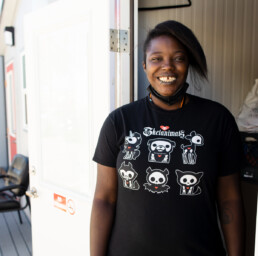
Gigi came into this world a fighter. “I am a miracle baby, technically,” she says, standing inside her People’s Village unit. “I wasn’t supposed to be here. My mom was told by doctors that she couldn’t have a child.”
Gigi was born a month and a half premature, on December 30, 1993. “I was the size of a preemie baby but somehow weighed the amount to go home the next day. So they let me go home,” she says. Then, three months later, her mother collapsed in their home. “My dad tried to revive her. But she was pronounced dead at the same hospital that I was born in.”
At only 28 years old, she has been through a lot in her life. She has bounced between homelessness and abusive homes, first staying with a cousin, then a friend of her father, both of whom physically abused her. “Me and my dad have been homeless on and off….But I was basically just…couch surfing, not really having like a stable spot.”
In 2008, she and her father moved in with her aunt in Santa Rosa, where Gigi attended high school. This offered a brief respite, until she met her ex-boyfriend. “He wouldn’t let me go outside at night,” she says. “He was controlling what I ate, when I ate, and how much…but I was like, I have no money and I need a place to stay. I was trying to save up money but most of my money went to him.”
She became homeless again after a series of personal crises, starting with a mental health break in 2018. “I got sent to a mental hospital in San Francisco,” she says. “And then [my ex] broke up with me when I came back. So I moved into my friend’s mom’s house and [stayed] there for three years.” And life didn’t let up after that. In 2021, her fiancé tried to kill her. The next month, November, she was told to leave her home. “Then I had a seizure and died in December, and was homeless basically from there.”
She went back to a mental hospital in January, followed by a stay in a crisis residential unit (CRU) for 30 days in February. “And then I went to The Rose, which is a family and women’s shelter.….I only stayed there for a week before I went back to the CRU residential unit.”
She found COTS through a friend she met at the mental hospital. “Originally, I didn’t want to come all the way out here in Petaluma,” she says. “I just wanted to stay in Santa Rosa. But the other shelters were either full or they weren’t accepting people because of COVID. Or they just didn’t call me back or answer the phone.”
While staying at COTS, Gigi decided to help out in the kitchen at Mary’s Table. That’s where she met COTS’ head chef Janin, who recommended she attend Homeward Bound’s culinary school, the same chef training program Janin herself graduated from. “At first I was like, I’m probably not even going to finish,” she recalls. “[But I thought], ‘I’m gonna be here for six months, I gotta do something other than just sit on my butt all day.’ So I went. And then next thing I knew, I’m running home every day like ‘look what I made, look at all the cool stuff I made!’ So now I love it.”
After she had been at the Mary Isaak Center for almost six months, she was able to secure a unit in the People’s Village, a week before her shelter exit date This allowed her to focus on her training at Homeward Bound, as well as her mental and physical health, something she had a hard time doing while staying in the congregate setting of the shelter. “It’s just the best thing ever, you know; I don’t worry about my mental stuff. I still worry about the seizures that I have every once in a while. We know that it’s triggered by how I’m feeling and panic attacks, so as long as I’m just cool and calm and I take my meds I’m fine.”
She has since graduated the program and passed the manager test, and has been working at Homeward Bound in the Key Room, a fully functioning kitchen and event space that not only caters for outside events but also provides dinners for Homeward Bound’s affiliate shelters. “I get $22 an hour for doing something that I love in a place that I like, and I’m happy about,” Gigi says. “The saying is, if you find something you love, you never work a day in your life; that’s where I’m at right now. And I’m only 28!”
The first time we talked to Gigi was last October. She had just secured her People’s Village unit, and was hopeful for the future.


Now, Gigi is living in her own place, an apartment she rents thanks to a partnership with Buckelew, and her spirits continue to look up. “This is also my first time living by myself,” she says. “This is a big transition for me. I’m used to being around like a bajillion and three people and waking up in the middle of the night….But now, it’s quiet. I like it.”
Though she’s still getting settled (when we spoke to her last, she’d only been moved in a week), she now has room for all her things, and is excited to have designated spaces for different items – a kitchen, a living room, a bedroom, a bathroom. “This is a giant castle to me compared to what I’ve been dealing with,” she laughs.
Sometimes, when she’s talking to someone, she pauses and savors the feeling of having her own place. “It’s nice to say ‘my place,'” she says. “This is my place, just me. All me, all mine. I did this. I got here. It’s nice. It’s really nice. I’m happy that I was able to move in.”
Talking to her, you would never know she has been to Hell and back. She smiles, laughs, tells funny stories, and shows off her Pokémon plushie collection. “It’s the little things, that’s what gets me by,” she says. “There’s always a silver lining to everything, you know. Just know that it’s a roller coaster; for every down, there’s an up. It’s been [a ride]. But right now I’m going up, I’m goin’ to the moon!”
“I’m not gonna lie, I’ve tried to kill myself a couple of times,” she adds. “But now I’m like, You know what? I don’t want to die, I don’t want to do that anymore. I’m doing a lot better. I talk to a therapist and psychiatrist, make sure I take my meds. I just try to just center myself and do me.
“I’ve had people say that I wasn’t going to amount anything or I wasn’t going to accomplish stuff or whatever. But I graduated high school with a 4.0, without trying. I went to two different culinary schools…I’m a certified massage therapist.
“I like to help people, put a smile on people’s faces. Handing them food that’s tasty, giving them a massage or giving them a good mixed drink, it’s just icing on the cake.”
A Mother's Hope
Homelessness often means that an individual hasn’t just lost their housing, but their relationships and community as well. This Mother’s Day we are highlighting one mother and daughter for whom addiction and homelessness severed their relationship, but through healing and support from COTS was restored.
As a child and young adult, Diana was close to her mom Beverly. They did everything together, like shopping and going to the movies. But things began to change. A traumatic experience caused Diana to keep parts of her life secret. “I didn’t know how to talk about it and I turned into a very secretive person,” said Diana. Diana’s alcoholism further separated her from her mother and eventually caused Diana to become homeless.
“So, when you're homeless, for me, I was very embarrassed,” said Diana. “I knew that the minute I asked for help, I would have to stop drinking. And I wasn't ready at that time.” Beverly knew that Diana was homeless. “I was terrified, she said, “that's the only word I can use. I looked for her all the time.”
After a few shelter stays, Diana came to COTS. Through support and determination, Diana was able to become sober, get a new job, and gain housing. One day, after a few years of stability and sobriety, Diana’s partner suggested she call her mom. So, she did.
Beverly was beyond thrilled. “Oh my God, it was the happiest day of my life,” she said. “I was on top of the world. Anybody who knows me saw the biggest change in me you could ever imagine, because I always felt like I just couldn't be happy, not knowing how my daughter was. And to get a call like that…I just couldn't wait to see her. I couldn't wait to put my arms around her.”
Today, their relationship is stronger than ever. They are back to shopping, going to movies and more. “Our relationship now is wonderful,” said Beverly. “We love being together. We laugh a lot. We chatter away incessantly.” Diana credits the mental health support she received at COTS with not only helping her personally, but also helping her relationship with her mother. “Therapy, I think that was one of the biggest turning points in my entire life,” said Diana.
Homelessness doesn’t just affect one individual. The loss of connection can be devastating to families, but the connection doesn’t have to be lost forever. When meeting other families in this same experience, Beverly refers them to COTS. “The success rate, what they offer, it’s just wonderful.”
The COTS Collective: April 2023


New Beginnings for People’s Village Residents Moving into Studios at Montero
COTS is proud to partner with Burbank Housing in the provision of supportive services at our newest project, Studios at Montero. From comprehensive case management to job assistance, healthcare navigation, and social events with peers—these residents will have access to necessary resources to help them navigate their exciting transition into permanent housing.
Studios at Montero, located in Petaluma, will house 60 individuals who have experienced chronic homelessness in our community. Each unit comes outfitted with a kitchenette, bathroom, and studio living space. All units are fully remodeled, with four ADA-accessible units available. Every unit will be furnished with basic household furnishings, and every resident will receive a “Welcome-Home” basket filled with household necessities like food, toiletries, and cleaning supplies.
Studios at Montero residents each have unique backgrounds, experiences, and skills. Onsite groups and recreational activities will allow residents to build a sense of community and belonging in their new homes—this type of peer connection helps ensure each resident successfully maintains permanent housing for many years to come.
Seven residents will be moving from the COTS People’s Village project into Studios at Montero, a true testament to the power of organizations like COTS in moving chronically homeless Sonoma County residents into permanent housing. All of these residents have experienced chronic homelessness in Sonoma County, and for many, Studios at Montero will be their first permanent home in more than ten years.
COTS staff have worked tirelessly for the last six months preparing future Studios at Montero residents for move-in day. The COTS team is beyond excited to welcome residents into their new homes, and we hope you will join us in congratulating each new resident!
If you are interested in donating to a COTS program, or donating items to fill a welcome-home basket, please visit www.cots.org or email Diana Morales at [email protected].
Thank you for your ongoing support of our critical programs.We hope to see you at a COTS event soon!
Until next time,
Chris Cabral
Mission Moment: From Homelessness to Housed—COTS’ Integrity House Program Highlight
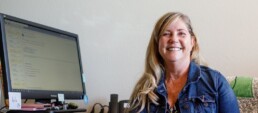
COTS Integrity Housing Care Manager Debbie Robbins
The COTS Integrity Housing program provides permanent housing options for individuals experiencing homelessness in Sonoma County. Residents receive case management services as well as other supportive services to ensure they remain safely and stably housed.
COTS is proud that over 95% of our Integrity House resident remain housed. This is a testament to the effectiveness of supportive services combined with permanent, affordable housing.
When Sheryl came to COTS, she was nervous about entering a new environment. “I was scared and angry,” she said. “I had never been homeless before and it was really hard to be around all these different people…”
Initially, Sheryl came to COTS through our Recuperative Care program. After receiving necessary healthcare, Sheryl transitioned to the Mary Isaak Center shelter. Sheryl understood the value of community and belonging and began to volunteer her time working in the COTS Kitchen serving her fellow COTS clients. Sheryl also began to attend COTS’ supportive groups including Qi Gong and Art Group as she focused on her own recovery and made strides toward her housing goals.
For several months, Sheryl worked alongside her COTS CareManager. She successfully increased and stabilized her income through Social Security and obtained a housing voucher through the Sonoma County Housing Authority. When Sheryl learned that COTS’ Integrity Housing program had a room for rent, she jumped on the opportunity to apply. By utilizing her voucher, Sheryl pays a small portion of her income as monthly rent, and now has a permanent place of her own.
According to Sheryl, “I feel very safe at COTS. I know that if something were to happen…that COTS would help me. I’m glad that I got into Integrity [Housing] because I’m not ready to cut the cord with COTS. I feel comfortable having my first place after homelessness being a COTS place.”
The entire COTS team would like to congratulate Sheryl on her successful transition into permanent housing. Here at COTS, we work tirelessly to provide wraparound services and innovative housing options for people experiencing homelessness. We will forever envision a community where everyone has a place to call home.
If you are interested in supporting our critical work in the community, visit us at www.cots.org.
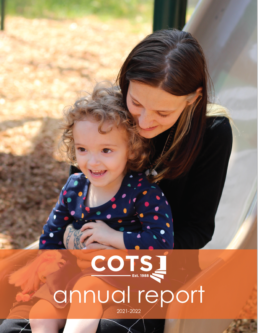
Our Annual Report for FY 2021-22 is now available online. You can view it at cots.org or by clicking the link below.
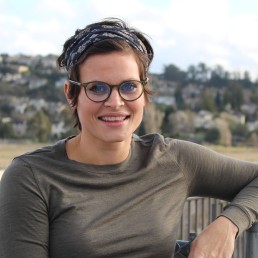
Sincerely,

Chris Cabral, CEO
The COTS Collective: March 2023


Spring Forward – Sunny Weather, and New Opportunities
Now that it’s officially Spring, we have much to celebrate! Here at COTS, Spring means abundant sunshine, healing nature walks, fun community events, and new opportunities to serve our community.
This Spring, COTS will celebrate its 35th anniversary at our annual fundraiser, Hops for Homes. We welcome you to join us for dinner, drinks (non-alcoholic beverages also available), live music, and stories of our work in the community. This year’s fundraiser is on April 27th at Brewster’s Beer Garden in downtown Petaluma. Please join us to celebrate our successes, learn about our programs, and to meet other supporters like you. Get your tickets here!
Spring also brings sunshine, warm weather, and beautiful wildflowers peppering the green hills around Sonoma County. We recognize that connecting with nature can be healing for many—that’s why the COTS Social Supports Manager leads nature walks for clients to relax, recharge, and develop bonds with their peers. As the rain fades, clients and staff are excited to explore the natural beauty of Sonoma County once again!
Spring also marks the season of growth for COTS. March through May is grantmaking season, bringing new opportunities for COTS to best support those we serve. COTS is renewing its focus on a housing-focused approach to services, and that means analyzing our programs to identify existing service gaps. The COTS team is hard at work identifying funding sources to address these gaps. We look forward to providing an update on our growth trajectory in the coming months.
We hope that all of you have exciting plans for the Spring. We are honored to receive your support and look forward to seeing you at our Spring fundraiser!
Until next time,
Chris Cabral
Mission Moment: Volunteers Make All the Difference
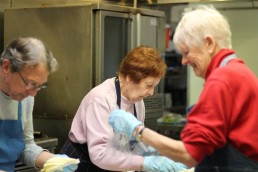
COTS relies on a core team of volunteers who help us offer a range of services. From helping in the kitchen at Mary’s Table, to providing transportation, to assisting clients obtain documentation for housing, these volunteers are critical to our success in the community.
The work we do every day is hard, complex, and rewarding. Our volunteers know the feeling of serving a warm meal to someone in need, helping a family navigate housing resources, or helping a client apply for a job as they reintegrate into our community. They know the joy of getting to know our clients as individuals. This year, we hope to expand our volunteer opportunities to better enrich the lives of those we serve every day.
Do you want to help our amazing kitchen team prepare hot and nutritious meals every week? Perhaps you would like to help us pick up regular donations throughout the community?
One-time volunteer opportunities for individuals and groups are also available. Are you a musician or artist interested in teaching a class or performing at the Mary Isaak Center? Maybe you’re a Wellness Coach or a Financial Advisor interested in talking to vulnerable community members about small steps they can take toward self-sufficiency. Or perhaps your company or team is looking for a way to give back to the community together. Our volunteers come from all walks of life, and they all have unique reasons for their commitment to serving COTS.
All COTS programs rely heavily on community supporters, including our cherished volunteers. The entire COTS team is honored to work alongside dedicated, talented, and passionate volunteers every day.
Are you interested in volunteering at COTS? We would love to hear from you! Please reach out to us at [email protected] to learn more.
To our cherished volunteers—thank you for all you do.

Sincerely,

Chris Cabral, CEO


